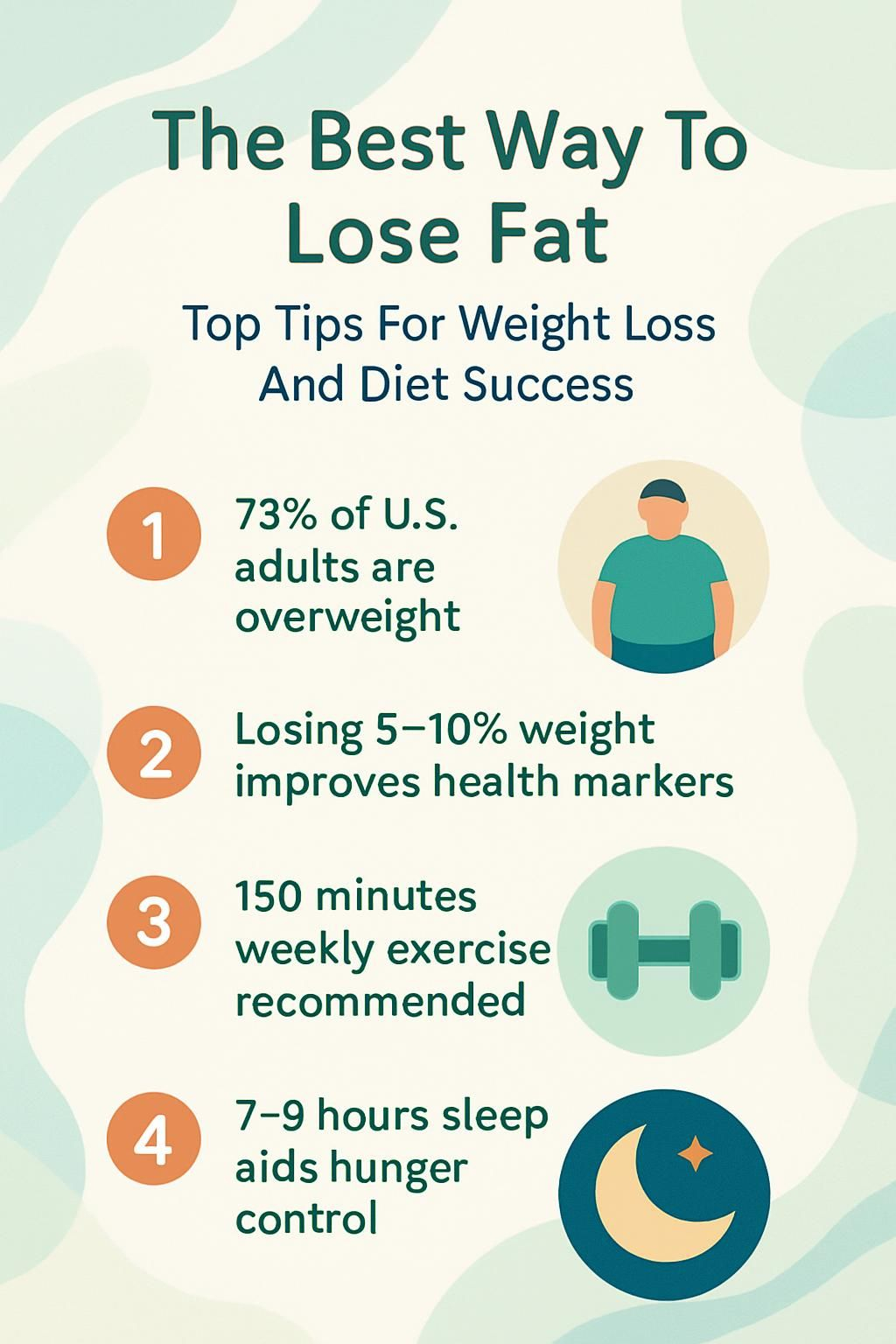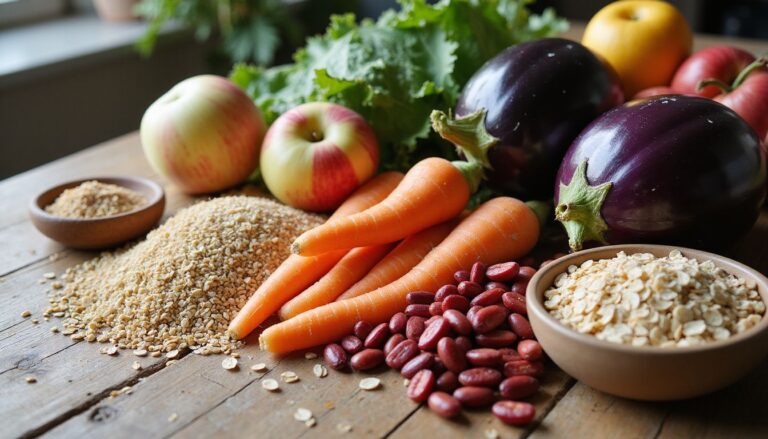The Best Way To Lose Fat: Top Tips For Weight Loss And Diet Success
Our Nutrition Assistant AI Suite will transform your body. You will lose fat, get toned, and build muscle. Gain confidence and optimal health.
You work hard to lose weight, yet the scale barely moves. You are not alone. About 73 percent of U.S. adults live with overweight or obesity, which raises the risk of heart disease and type 2 diabetes.
This guide breaks down practical ways to lose fat with healthy eating, regular exercise, and simple lifestyle shifts you can follow. You will find science-backed tips that fit real life and support steady weight loss.
Use these strategies to build a healthy weight plan you can stick with.
Key Takeaways
- About 73 percent of U.S. adults have overweight or obesity, which raises the risk for heart disease and type 2 diabetes, according to the CDC.
- Losing 5 to 10 percent of body weight lowers inflammation, improves cholesterol, and reduces blood glucose for measurable health gains (Nutrition Reviews 2016).
- Eating more whole foods, raising protein, adding soluble fiber, and avoiding trans fats supports fat loss and lowers long-term disease risk (Harvard Health Publishing).
- Effective fat loss pairs aerobic exercise with strength training two or three times weekly, plus at least 150 minutes of total moderate activity each week (American Heart Association).
- Quality sleep, 7 to 9 hours, and stress control help regulate hunger hormones such as ghrelin and leptin, which supports long-term diet success (Annals of Internal Medicine).

Health Benefits of Losing Fat

Think of fat loss as easing the load on your body’s engine so it runs smoother. Losing fat can lower your risk of heart disease, type 2 diabetes, and several cancers. Many people also report better energy and a brighter mood as their weight drops.
How Does Fat Loss Lower the Risk of Chronic Diseases?
Carrying extra adipose tissue, meaning body fat, disrupts hormones like insulin and leptin. Too much fat can lead to insulin resistance, higher blood sugar, and strain on the heart and blood vessels. The CDC reports that people with obesity face a higher chance of high blood pressure and heart problems than those at a healthy weight.
Even modest fat loss helps. Dropping just 5 to 10 percent of your body weight lowers inflammation markers, improves cholesterol, and reduces stress on vital organs. That change sets off a chain of benefits you can measure in routine lab tests.
After college, I sat at a desk all day and gained weight around my waist. I made small swaps, like packed lunches and daily walks. In six months I lost 20 pounds, and my blood pressure moved from borderline high back to normal without medicine.
A loss of just 5% body mass yields measurable improvements in blood glucose control, reports Nutrition Reviews (2016).
Physical health and mental health move together; better numbers often come with better energy, focus, and confidence.
How Does Losing Fat Improve Physical and Mental Well-being?
Fat loss supports your entire body, not just your blood tests. You may breathe easier, move with less effort, and feel more capable in daily tasks. Losing belly fat lowers inflammation, which can improve heart health and blood flow, and may reduce blood pressure.^1
Regular activity during weight loss boosts endorphins, the body’s feel-good chemicals. Many people sleep better and feel less stressed as routines steady. Studies show that losing 5 to 10 percent of body weight links to better sleep, higher self-confidence, and fewer signs of depression.^2 Simple diet shifts, like adding whole grains and vegetables, help this process along.
Small wins stack up. Each healthy change can support your mood, your energy, and your long-term plan.
…
^1 American Heart Association: “Losing Weight Reduces Risk Factors for Heart Disease,” accessed March 2024.
^2 Harvard Health Publishing: “The Hidden Benefits of Weight Loss,” updated January 2023.
Key Differences Between Fat Loss and Weight Loss
Fat loss and weight loss are not identical. Chasing a lower number on the scale can cost you muscle if you use the wrong approach. Understanding the difference helps you protect lean muscle and improve body composition, which means the ratio of fat to muscle.
Why Are Calories and Metabolism Important for Fat Loss?
Your body burns calories to power movement and basic functions like breathing and digestion. Metabolism is the rate at which your body uses energy. If you eat fewer calories than you burn, you create a calorie deficit. That gap nudges your body to use stored fat for fuel.
A common estimate is that a weekly deficit of about 3,500 calories equals roughly one pound of fat. It is an average, not a rule, but it is useful for planning. Strength training raises your daily burn because muscle uses more energy than fat at rest. Aerobic exercise, like brisk walking or cycling, also increases daily energy use.
Tracking food intake and activity makes it easier to manage your deficit and reach weight loss goals. I added a 30 minute walk most days and adjusted my snack sizes. Belly fat started to drop week by week.
You need a calorie deficit, created through diet, activity, or both, for effective fat loss, says Dr. Yoni Freedhoff, University of Ottawa.
Cutting added sugar and choosing whole grains, like brown rice instead of white bread, can steady hunger and energy. That stability makes the plan easier to follow.
Diet Tips for Effective Fat Loss
Food choices drive most fat loss results. Aim for balanced meals, steady protein, and filling fiber. These simple moves help you lose belly fat and support a healthy lifestyle.
What Are the Best Whole Foods and Balanced Meals for Fat Loss?
Whole foods work best. Build meals with vegetables, fruits, whole grains, eggs, fish, lean meat, beans, nuts, and seeds. A plate with grilled chicken, quinoa or brown rice, leafy greens like spinach, and a drizzle of olive oil delivers protein for muscle repair and fiber for digestion.
Greek yogurt with berries offers calcium and antioxidants that support weight management. Plant-forward meals that use beans or lentils instead of processed meat can lower calories while keeping you full because of soluble fiber. Vegetables help you eat fewer calories without hunger since they are nutrient dense but low in energy.
Swap refined grains for whole versions. Pick whole grain bread or bran cereal rather than white rice or white bread. Add healthy fats from avocado or olive oil to help control appetite and avoid packaged snacks loaded with trans fats and added sugars.
How Can Adding More Protein Help Lose Fat?
Protein supports fat loss in two key ways. First, it increases fullness, which helps you stick to a calorie deficit. Second, your body uses more energy to digest protein than it does for carbs or fat, a process called the thermic effect of food.
Higher protein helps you keep lean muscle while losing fat. That protects your metabolism. Research in the American Journal of Clinical Nutrition shows people who raise protein tend to lose more body fat while maintaining muscle compared to lower protein diets.
Good options include eggs, beans, Greek yogurt, poultry, fish, tofu, and cottage cheese. Aim to include a protein source at each meal to stabilize hunger and support recovery from workouts.
What Are the Benefits of Soluble Fiber for Fat Loss?
Soluble fiber dissolves in water to form a gel-like substance in your gut. It slows digestion and helps you feel full longer, which can lower calorie intake. You will find soluble fiber in oats, beans, apples, citrus, chia seeds, and some vegetables.
Research links higher soluble fiber intake to a lower risk of belly fat gain over time. One study in Obesity (2012) found each 10 gram increase per day was tied to a 3.7 percent lower rate of belly fat gain across five years.
Soluble fiber also helps control blood sugar by slowing the absorption of sugars. That steadies insulin, the hormone that helps your body store or use sugar. I added black beans and chia seeds to lunches, and cravings dropped while meals stayed satisfying.
Focus on fiber rich foods to support a balanced diet, steady energy, and long-term success.
Why Should You Cut Out Trans Fats?
Trans fats raise LDL cholesterol, the type that clogs arteries, and lower HDL, the protective type. Diets with trans fats link to a higher risk of type 2 diabetes, stroke, and heart disease. The FDA banned artificial trans fats from packaged foods in 2018 because they are unsafe.
Even small amounts in processed snacks, certain baked goods, and some fast food can inflame your body and slow fat loss. During my own cut, removing foods with trans fats reduced bloating and improved my energy. Swapping in whole foods, nuts and seeds, fresh produce, lean proteins, and olive oil helped the last pounds come off.
Watch added sugars and refined carbs as well, since they often travel with trans fats in ultra processed products.
How Does Reducing Added Sugar and Refined Carbs Help?
Added sugar and refined carbs, like soda, candy, white bread, and many pastries, spike blood sugar. Your body releases more insulin to handle the surge. High insulin makes fat storage more likely and fat burning harder.
Choosing whole grains and high fiber foods supports weight loss because they digest slowly and keep you full. Many studies show that lower added sugar intake lowers the risk of heart disease and type 2 diabetes. Skipping just one can of regular soda per day saves about 150 calories; that can add up to around 15 pounds in a year without extra exercise for weight loss[1].
Swap refined carbs for whole fruits, vegetables, beans, nuts, and lean proteins such as chicken or fish. You will gain nutrients and support fat loss at the same time.
…
[1] Harvard T.H. Chan School of Public Health: “Sugary Drinks.
Why Is Staying Hydrated Important for Fat Loss?
Water helps your body burn calories and can curb appetite, since thirst often feels like hunger. Drinking about 17 ounces of water has been shown to raise resting metabolism by up to 30 percent for about an hour in some studies.
Hydration matters even more on workout days. Sweating during steady-state cardio or high-intensity intervals increases fluid needs. I noticed that eight cups a day trimmed my cravings and kept my runs steady. Replacing sugary drinks with water cuts added sugar and supports a nutritious diet while you lose weight.
Exercise Strategies That Promote Fat Loss
Exercise helps you burn calories, keep muscle, and maintain your new weight. A smart plan mixes aerobic exercise with strength work so you lose fat without sacrificing lean tissue.
What Are the Benefits of Steady-State Cardio Like Walking, Running, and Cycling?
Steady-state cardio means moving at a moderate, steady pace. Activities such as brisk walking, light jogging, or cycling help you burn calories and use fat as a main fuel source during longer sessions.
The American Heart Association recommends at least 150 minutes of moderate aerobic activity each week for heart health and blood pressure control. These activities are joint friendly and easy to fit into daily life. Over time you will notice better endurance, stronger legs, and a more stable mood.
Stay consistent and progress slowly. Many people find steady-state sessions easier to sustain than all-out efforts, which helps with steady fat loss.
Why Choose High-Intensity Interval Training (HIIT) for Fat Loss?
High-Intensity Interval Training, HIIT, alternates short bursts of hard effort with brief rests. For example, sprint for 30 seconds, then walk for 60 seconds, and repeat. HIIT raises your heart rate fast and is time efficient.
Short HIIT workouts, 15 to 30 minutes, can burn as many calories as longer steady sessions. You also get an afterburn effect called excess post-exercise oxygen consumption, or EPOC, where your body uses extra energy while it recovers.
Research suggests that adding HIIT two or three times per week can improve fat loss compared to doing only steady cardio. If time is tight, a brief interval session may be your best exercise for weight loss that day.
How Does Strength Training Increase Lean Muscle?
Strength training creates small tears in muscle fibers, which your body repairs stronger. Over time you gain lean muscle, and muscle burns more calories than fat at rest. That means a higher basal metabolic rate, the energy your body uses to live even when you are not moving.
Training two or three times per week can raise resting metabolism within weeks. Adequate protein speeds repair and curbs hunger. A simple post workout meal, such as chicken with rice or yogurt with fruit and nuts, supports recovery and keeps you satisfied.
Within a month of consistent lifting, I felt stronger and my clothes fit better. Extra lean muscle shapes your body and supports long-term weight maintenance.
Daily movement also matters. The more you move, the easier fat loss becomes.
Why Is Daily Physical Activity Important for Fat Loss?
Daily movement increases total calories burned, even outside the gym. Walking, biking to the store, or taking the stairs all add up. People who move more day to day tend to lose more weight over time than those who rely on dieting alone.
Regular activity also helps regulate hunger hormones, which supports better food choices. Health professionals suggest aiming for at least 150 minutes each week for weight loss and maintenance. You do not need marathons. Park farther away or take a 10 minute walk after meals to build the habit.
Small actions repeated often can trim fat while keeping your heart and blood vessels healthy.
Lifestyle Adjustments for Better Fat Loss Results
Simple habit shifts amplify your results. Sleep, stress control, and mindful eating help your plan stick and make daily choices easier.
How Does Quality Sleep Affect Fat Loss?
Sleep affects hunger hormones. Short sleep raises ghrelin, which increases hunger, and lowers leptin, which signals fullness. That imbalance can trigger extra snacking and overeating.^1 Your metabolism can also slow with poor sleep, which makes fat loss harder.
A study in the Annals of Internal Medicine found that people on a low-calorie diet lost more fat when they slept 7 to 9 hours compared to those who slept less.^2 Good sleep also improves stress control, which helps you avoid emotional eating.
On nights when I slept only five hours before an early workout, cravings for salty snacks jumped the next day. Protecting sleep protects your plan and supports your heart and circulation by keeping blood pressure steadier.
…
^1 Spiegel K., Tasali E., Penev P., Van Cauter E., “Brief Communication: Sleep Curtailment in Healthy Young Men Is Associated with Decreased Leptin Levels, Elevated Ghrelin Levels, and Increased Hunger and Appetite,” Annals of Internal Medicine (2004).
^2 Nedeltcheva AV et al., “Insufficient Sleep Undermines Dietary Efforts to Reduce Adiposity,” Annals of Internal Medicine (2010).
What Are Effective Ways to Manage Stress for Fat Loss?
High stress shifts hormones, raises appetite, and can slow fat loss. A simple stress plan keeps your routine on track and your meals steady.
- Practice slow, deep breathing daily to calm your nervous system and reduce tension.
- Schedule regular activity such as walking or cycling to lower cortisol, the primary stress hormone.
- Limit caffeine after noon if it makes you jittery or disrupts sleep.
- Try meditation or yoga. Research links both with lower chronic stress markers and better heart health.
- Reach out to supportive friends or family. Positive connection eases cravings driven by stress.
- Keep a steady meal routine with lean protein and fiber to steady blood sugar and mood.
- Track stress triggers in a journal or app. Spotting patterns helps you plan solutions in advance.
Daily walks with my dog helped me clear my head and kept me active. A short stress log made me more aware of emotional eating triggers and helped me course correct fast.
How Can You Practice Mindful Eating?
Mindful eating improves your relationship with food and makes fat loss feel more natural. You tune into hunger, fullness, and satisfaction rather than eating on autopilot.
- Eat without screens. Focus on flavor, texture, and aroma to slow down.
- Chew slowly. It improves digestion and gives your brain time to register fullness.
- Follow hunger and fullness cues, not only the clock.
- Choose whole foods like fruits, vegetables, lean protein, nuts, and seeds for lasting satisfaction.
- Use smaller plates or bowls to help with portions.
- Drink water before meals to support hydration and appetite control.
- Pause halfway through and check if you are still physically hungry.
- Practice gratitude for the meal. A brief pause encourages slower, more thoughtful eating.
- Keep a short food log to build awareness. It works with many plans, from time-restricted eating to low-carb.
- Avoid all-or-nothing labels. Allowing small treats makes healthy habits easier to maintain.
These steps support diet success and a calmer mind. The goal is progress, not perfection.
How Do You Set Realistic and Achievable Fat Loss Goals?
Clear goals keep you focused. Evidence-based steps, measured each week, improve your chance of steady progress and weight loss maintenance.
- Start with Specific Targets
Choose a safe rate, about 1 to 2 pounds per week. This helps ensure most of the loss comes from fat rather than water or muscle. - Break Goals Into Short-Term Steps
Pick small weekly actions, like swapping refined grains for whole grains or adding a veggie at lunch. Small wins build momentum. - Track Progress Beyond the Scale
Measure your waist, note strength gains, or check how clothes fit. Water shifts can mask fat loss on the scale. - Use Peer-Reviewed Methods
Choose well-studied plans such as the Mediterranean or DASH diets. They balance protein, healthy fats, and fiber and support heart health. - Set Actions You Can Control
Focus on behaviors, like “I will walk 30 minutes daily,” rather than only chasing a number. - Adjust Goals Based on Your Experience
If you plateau, review calorie intake, protein, sleep, and activity. Tweak the plan and continue. - Celebrate Each Milestone
Reward progress with non-food treats, like new workout gear or a favorite healthy recipe.
I tracked calories, added protein, and ran three days a week. Slow, steady steps turned into big changes I could maintain.
Comparing Popular Fat-Loss Diet Plans
Many diet plans promise quick results. The best plan is one you can follow and that supports your health markers over time.
What Are the Pros and Cons of Low-Carb Diets?
Low-carb diets, including keto, reduce refined carbs and added sugar. This can improve insulin control and help you lose fat, especially at first. Higher protein and fat often increase fullness, which makes a calorie deficit easier to maintain.
That said, early side effects can include headache, fatigue, and constipation as your body adapts. Very low carb plans may limit fruit and whole grains, which can cut fiber and some vitamins. Cutting entire food groups can feel restrictive and hard to sustain. Review high quality research and consider a registered dietitian if you have health conditions.
How Does Intermittent Fasting Work for Fat Loss?
Intermittent fasting limits the hours you eat. A common plan is 14 to 16 hours of fasting, then an 8 to 10 hour eating window. This structure often reduces total calories, which helps fat loss.
Studies suggest intermittent fasting can improve insulin sensitivity, lower average blood sugar, and increase fat oxidation. Many people find meal planning simpler with fewer meals. I felt more alert during morning fasts and found it easier to control calories by starting at noon.
Track your response weekly. If sleep, mood, or workouts suffer, adjust your window or try a different approach.
What Are the Benefits of the Mediterranean Diet?
The Mediterranean diet focuses on food quality rather than strict rules. It highlights fruits, vegetables, whole grains, nuts, seeds, olive oil, fish, and lean proteins. A landmark 2013 trial in the New England Journal of Medicine linked this pattern to about a 30 percent lower risk of heart attack or stroke.
Meals are flexible, tasty, and satisfying. When I shifted from ultra processed foods to fresh produce and olive oil, I felt fuller and lost belly fat over several months. Many people also report better energy and mood with this pattern.
It is a strong option for long-term weight management and overall health.
What Is an Overview of the Ketogenic Diet?
The ketogenic, or keto, diet is very low in carbs and higher in fats. Most people limit carbs to about 20 to 50 grams per day. That low intake puts your body into ketosis, a state where you burn fat for fuel.
Keto can help with weight loss and may improve blood sugar and cholesterol in some people. Typical foods include eggs, meat, cheese, nuts, avocados, oils, and leafy greens. You avoid bread, pasta, sugary snacks, starchy vegetables, and most fruits.
Many find cravings drop when they follow the plan closely. If you choose keto, monitor how you feel and check key health markers with your clinician.
Avoid These Common Fat Loss Mistakes
Small missteps can pile up and slow results. Spotting common traps early keeps progress steady and prevents burnout.
What Are the Dangers of Over-Restricting Calories?
Slashing calories too low can backfire. Your body may reduce its resting metabolism to conserve energy, which makes fat loss harder. A 2016 study showed resting metabolic rate dropped as much as 20 percent with long-term severe restriction.
Very low intake also risks muscle loss, poor focus, mood swings, headaches, and sleep problems. I tried cutting way too low once. Cravings spiked, energy crashed, and progress stalled.
Extreme diets can also cause nutrient gaps that weaken your immune system and bones. Very low-calorie diets should only be used with medical supervision. Balanced meals and a moderate deficit work better for long-term success.
Why Is Skipping Meals Risky for Fat Loss?
Skipping meals can slow metabolism and push your body to conserve energy. You may get very hungry later, which raises the odds of overeating at night. Research links skipped meals with lower diet quality and poorer weight loss outcomes.
Energy dips also make workouts harder to complete. A steady meal pattern helps maintain focus, supports exercise for weight loss, and makes a calorie deficit easier to manage.
What Are the Drawbacks of Fad Diets?
Fad diets often promise fast results without strong evidence. Many cut whole food groups, which can cause nutrient shortages. Eliminating carbs entirely, for example, may cause fatigue and irritability because the brain uses glucose for fuel.
Some extreme plans reduce calories too much and lack enough protein, which risks muscle loss instead of fat loss. Most people regain much of the weight within two years after strict fad diets end (Brownell et al., 2017). I tried a juice cleanse before a school event and felt lightheaded all day because my body lacked key nutrients.
Choose plans you can maintain, backed by peer-reviewed research, and protect your health while you lose fat.
Why Are Consistency and Patience Necessary for Fat Loss?
Daily habits, repeated, deliver the win. Healthy fat loss usually averages 1 to 2 pounds per week. Your body needs time to drop fat, preserve muscle, and adapt its metabolism.
If the scale stalls, look for other signs such as smaller waist, better workouts, or improved sleep. Fast losses often lead to muscle loss or later regain. Steady effort prevents burnout and supports long-term weight management.
Keep going, even when progress feels slow. Small steps stack into big change.
How to Monitor Your Fat Loss Effectively
Tracking makes your plan visible. Simple measurements reveal what works so you can adjust with confidence.
How Can You Track Your Diet and Exercise Accurately?
Accurate tracking improves results because it closes the gap between what you think you do and what you actually do.
- Keep a daily food journal. Log meals, snacks, drinks, and portion sizes.
- Use nutrition apps such as MyFitnessPal or Cronometer with barcode scanners for precise entries.
- Weigh foods with a kitchen scale. It reduces guesswork and hidden calories.
- Wear a fitness tracker to log steps, activity, and heart rate. These tools can increase daily movement.
- Record strength sessions. Track sets, reps, and weights to see progress and protect muscle.
- Take weekly progress photos in the same lighting and pose to see visual changes.
- Measure waist circumference weekly. Belly changes often show before the scale moves.
- Review logs each weekend to spot patterns, like late-night snacking or missed workouts.
- Note energy and mood after meals or workouts to learn what supports your best days.
- Share your data with a registered dietitian or coach for professional feedback.
- Use your records to set realistic goals. Seeing steady trends builds motivation.
What Are Ways to Assess Fat Loss Beyond the Scale?
The scale tells only part of the story. Combine several checks to get a fuller picture of fat loss.
- Track body measurements, including waist, hips, arms, and thighs. Smaller waist links with lower disease risk.
- Take progress photos every few weeks using the same lighting and posture.
- Note how clothes fit. Looser areas often show real body changes.
- Consider body fat measures such as skinfold calipers or bioelectrical impedance.
- Watch fitness improvements, like walking farther or lifting heavier with less effort.
- Track energy and mood. Higher energy often follows successful fat loss.
- Log sleep quality and hunger cues. Better rest supports diet success and less body fat.
- Ask your clinician to check blood pressure, cholesterol, and blood sugar to confirm health gains.
Using multiple tools gives you a clear view of progress even when the scale stays flat for a week or two.
Tips for Sustaining Fat Loss Long-term
Lasting results come from simple habits you can repeat. Build routines that fit your life, and allow small treats without letting them run the show.
How Can You Build Lasting Healthy Habits?
Habits reduce decision fatigue. The fewer choices you make under stress, the easier it is to stay consistent.
- Set clear, realistic action goals, such as eating one extra vegetable daily or walking 20 minutes after work.
- Track progress with a journal or app. Self-monitoring supports better weight management.
- Start with small swaps, like water instead of soda, or smaller plates for portions.
- Plan meals in advance to avoid last-minute choices that do not fit your plan.
- Find social support. Friends, family, or a group can keep you accountable.
- Celebrate non-scale wins, such as better sleep, steadier mood, or stronger workouts.
- Build routines so healthy actions run on autopilot.
- Stay flexible. Adjust when life changes, and keep moving forward.
These steps support sustainable fat loss and better health, backed by nutrition research.
How Do You Balance Treats with Healthy Choices?
All-or-nothing thinking can derail progress. Planned treats reduce cravings and make your plan livable. Studies in the American Journal of Clinical Nutrition suggest flexible diets are easier to maintain.
Set a weekly treat limit or pick one meal to enjoy dessert while keeping other meals nutrient dense. I scheduled a small chocolate treat every Friday. It fit my calories and took the edge off cravings without guilt.
This approach keeps you in control while you enjoy your favorite foods in moderation.
Conclusion
Effective fat loss relies on steady habits and science, not quick fixes. Focus on whole foods, higher protein, fiber rich choices, and water. Pair aerobic exercise with strength training to protect muscle and boost your burn. Track what matters, not just the scale.
Set clear goals, monitor your progress, and adjust as needed. Consistency is your strongest tool for weight loss. Celebrate small wins, keep your routine simple, and build a plan you can live with.
Educational only, not medical advice. If you have a health condition or take medications, talk with a healthcare professional before major changes to your diet or exercise.
FAQs
1. What is the best way to lose fat according to peer-reviewed studies?
Peer-reviewed studies show that a calorie deficit, regular physical activity, and balanced nutrition are key for weight loss. Consistent habits help people reach their goals.
2. How do I know if my diet plan relies on credible sources?
A reliable diet plan uses information from peer-reviewed studies or trusted health organizations. Check if the advice cites scientific research or expert guidelines.
3. Why does weight loss often stall even with healthy eating?
Weight loss can slow due to changes in metabolism as you lose body mass. Peer-reviewed studies suggest tracking food intake and adjusting calories helps overcome plateaus.
4. Can personal experience support evidence-based tips for losing fat?
Personal stories can make evidence-based tips more relatable but should not replace data from peer-reviewed studies when it comes to weight loss guidance.
Summary: Effective fat reduction depends on proven methods such as calorie control and exercise, supported by credible research rather than anecdotal claims alone. Always check that your approach relies on trustworthy sources for lasting results.







